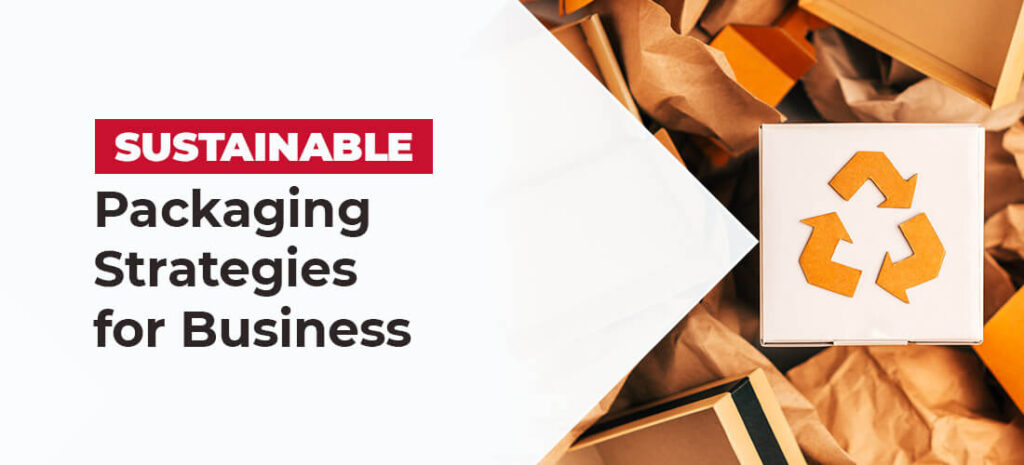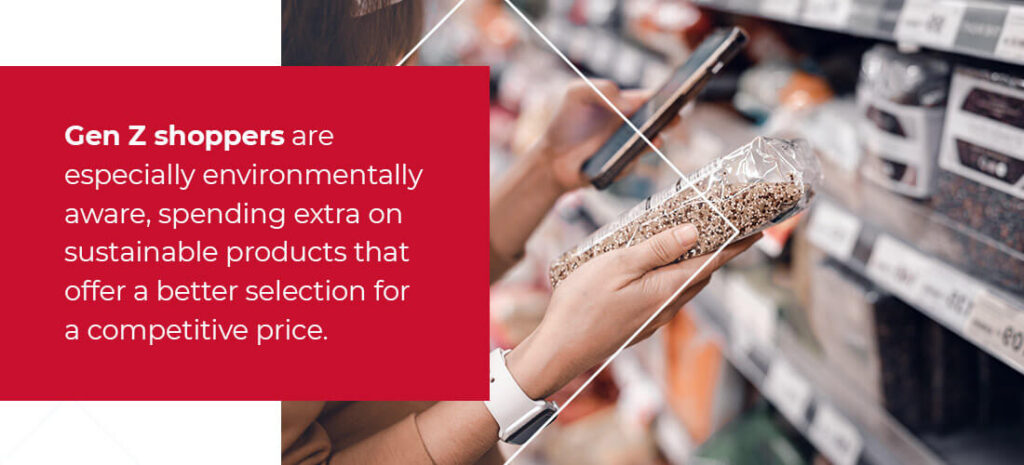Sustainable Packaging Strategies for Business

Sustainability is essential to customers and businesses looking to protect the environment from packaging that may negatively affect the natural world. Many consumers are looking for eco-friendly options through companies that are transparent about their materials usage and waste management.
What Is Sustainable Packaging?
Sustainable packaging uses materials that reduce a company’s carbon footprint and overall waste production. It can also help businesses increase sales while appealing to a more extensive customer base. Some retailers will also look for brands that offer eco-friendly options.
Why Is Sustainable Packaging Important?
It is helpful to review the four Rs of sustainable packaging to create solutions that satisfy the consumer’s needs. They are:
- Reduce: Create packaging that makes materials compact and lessens the amount of material used.
- Replace: Replace the plastic with sustainable material.
- Reuse: Reuse materials on replacement products.
- Recycle: Use recycled materials and products to create packaging.
E-Commerce and Online Ordering
Municipal solid waste (MSW) comprises many containers and packaging, and due to the growing number of online sales, more and more plastics and harmful materials are being thrown away. However, with the significant growth of e-commerce sales in the U.S., businesses are attempting to change towards eco-friendly and recyclable materials.
What Are the Largest Challenges Facing Sustainable Packaging Today?
When wondering how important sustainable packaging is, it is essential to explore the various challenges facing sustainable packaging solutions today. These include cost, time and appearance.
Cost of Sustainable Packaging Materials vs. Non-Sustainable Ones
One of the major issues holding companies back from sustainable packaging is cost. While sustainable packaging materials are better for the environment, they are more expensive than non-sustainable materials, which can prevent businesses from considering the switch.
Non-sustainable materials like plastic are often less expensive and easily produced in large quantities but can be detrimental to the environment over time. To solve the initial cost problem, many companies have begun to focus on reducing non-sustainable materials, such as using cardboard and paper products in place of plastic in packaging designs.
Integration Time
The time it takes to prepare sustainable packages may be another challenge to overcome. Many businesses shy away from sustainable materials due to the time it takes to fully integrate them, sometimes extending past six months. Companies may also have to consult with experts, which requires time spent on meetings, scheduling and testing the capability of the packaging.
Integrating sustainable packaging into your business model has to be a slow and careful process, whether that means focusing on reducing the number of materials you currently use or searching for eco-friendly replacements for plastic.
Appearance Issues
Appearance also impacts sustainable packaging. For example, you may have to transition graphics from shrink wrap to biodegradable paper and some designs may need to be altered. Businesses may worry that sustainable packaging materials will make the design look cheap, leading to a low-value perception among customers.
While it may sometimes be a challenge to transition graphics or logos, with the help of experienced designers, your company can identify the right packaging that suits both the product and the marketing materials.
Who Can Benefit Most From Sustainable Packaging?
All industries can benefit from using sustainable packaging. Businesses that sell to consumers may benefit the most by garnering public interest and positively impacting the environment. Consumers will consider buying from companies offering sustainable packages with long-term positive effects.
Do Consumers Prefer Sustainable Packaging?

Consumers of all generations, from Generation Z, Generation X and baby boomers, are willing to spend a bit more on products if it means the packaging is sustainable and eco-friendly. Gen Z shoppers are especially environmentally aware, spending extra on sustainable products that offer a better selection for a competitive price. Companies would do well to remember that brands and retailers can differentiate themselves from the competition by switching to sustainable packaging.
Environmentally Friendly Packaging Strategies
No matter what you are looking to design, there are many benefits to eco-friendly packaging. Check out three strategies companies can use to reduce the impact their packaging has on the environment.
1. Material Reduction
Reducing the number of materials used during the packaging process can be an efficient way to lower waste. One example is reducing the amount of shrink or stretch film used for products or finding ways to strengthen the plastic film so that less plastic is used over time.
With technological advances, the strength of stretch wrap has increased, providing thinner gauges with higher strength. For stretch film, it is important to test the films to ensure that your materials are durable to protect the product during shipping. While eco-friendly packaging should be the focus of the branding, durable materials will also prevent long-term expenses due to damaged goods.
Shrink film has also increased its strength with thinner gauges using more layers than ever in the extrusion process. Down gauging is a common practice to not only reduce your packaging but reduce your per package cost as well. Companies can even print graphics directly on shrink film to reduce the usage of paper inserts or labels, reducing your overall packaging and, increasing your throughput.
Finding a middle ground between durable packaging and sustainable materials will be essential. One way to do this is through downgauging and nanotechnology. Nanotechnology can increase the strength of materials while reducing the number of materials used. Graphene nanotubes, for example, can be stronger than steel, with great conductivity and anti-static abilities.
2. Recyclable Materials
It is easier than ever to find and use recyclable materials for your packaging needs. Companies like Clysar and Pregis have created innovative packaging designs and materials that are both eco-friendly and cost-effective. For example, Clysar® EVO™ and EVOX™ shrink films are recyclable through the How2Recycle® program.
Pregis EverTec™ has created a padded mailer made from recyclable materials that is both lightweight and functional, making it easier for companies to ship products while reducing non-sustainable materials and protecting their items.
When it comes to shrink sleeve and blister packaging, many companies have made the switch from polyvinyl chloride (PVC) to recycled polyethylene terephthalate (rPET). For example, rPET is an excellent example of recyclable plastic that can replace the usage of PVC, a synthetic material that is hazardous to the environment. PVC is not biodegradable and produces dioxin, a harmful chemical that can lead to cancer, congenital disabilities and endometriosis.
Meanwhile, rPET is a strong material that is recyclable, often used for soda bottles or food jars. It can also be used to make blankets, insulation or shoes. The recycling process involves gathering rPET and refining the material into new products you can later reuse.
3. Biodegradable, Recycled and Organic Materials
Companies following eco-friendly packaging trends will want to explore the various sustainable materials used for packaging that are made from natural and recyclable products. There are several pros to using biodegradable materials versus virgin resin. Virgin resin and plastics tend to pile up in landfills and use a dangerous amount of fossil fuels, and while companies may appreciate virgin resins for their durability and flexible molecular structures, they are hazardous to the environment.
Here are a few biodegradable packaging examples:
- Corrugated bubble wrap: This packaging is made from cardboard that has been scored and repurposed to provide a cushioned layer of protection.
- Recycled paper and cardboard: Paper and cardboard are biodegradable and have a low impact on surrounding environments.
- Organic fabrics: Organic fabrics can be made from hemp, flax, cotton, palm leaves, banana leaves and pineapple leaves. They can be used as bags and containers and are highly biodegradable.
- Cornstarch-based packaging: Made from corn, cornstarch-based packaging is more eco-friendly than plastic and is a versatile material that can be used in bottling brands or as loose-fill packaging.
- Biodegradable packing peanuts: These kinds of packing peanuts can be made from starch and wheat and are not harmful to marine life. They can also be lightweight with relatively low cost.
- Polylactic acid: Polylactic acid (PLA) is a kind of biodegradable plastic made from lactic acid and agricultural waste like cornstarch, sugarcane or beet pulp.
- Mushroom packaging: Made from mycelium or mushroom roots, mushroom packaging is biodegradable and eco-friendly.
A great example of a company developing biodegradable materials is Alliance. Alliance Steelflex Green and Steelflex Bio are stretch film options that combine virgin and recycled materials to reduce their overall waste production. Steelflex Bio offers excellent tensile strength and puncture resistance while being one of the industry’s quickest to biodegrade films and 100% recyclable.